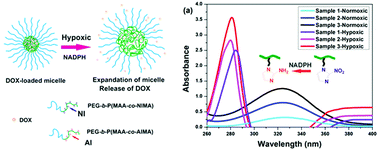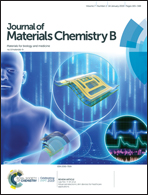Hypoxia-responsive micelles self-assembled from amphiphilic block copolymers for the controlled release of anticancer drugs†
Abstract
Amphiphilic block copolymers poly(ethylene glycol)-block-poly(methacrylic acid-co-2-nitroimidazole methacrylate) (PEG-b-P(MAA-co-NIMA)) were synthesized by the combination of atom transfer radical polymerization (ATRP), hydrolysis and EDC reactions. These copolymers could self-assemble into spherical micelles in water. 2-Nitroimidazole (NI) groups presented hypoxia-responsive properties under hypoxia conditions. The hydrophobic NI groups could be converted into hydrophilic aminoimidazole (AI) groups, which would lead to the expansion of micelles. Moreover, the content of NI groups in the copolymers would affect the hydrophilic–hydrophobic balance and therefore influence the self-assembly behaviour of the copolymer and the morphologies of the micelles. The copolymer micelles were used as a drug delivery system for controlled release of anticancer drug doxorubicin (DOX). The in vitro cytotoxicity investigation revealed that the DOX-loaded micelles showed higher toxicity to hypoxic cells than to normoxic cells. As a result, the block copolymers are expected to be used as an intelligent carrier for hydrophobic drugs to treat hypoxia-associated diseases.



 Please wait while we load your content...
Please wait while we load your content...